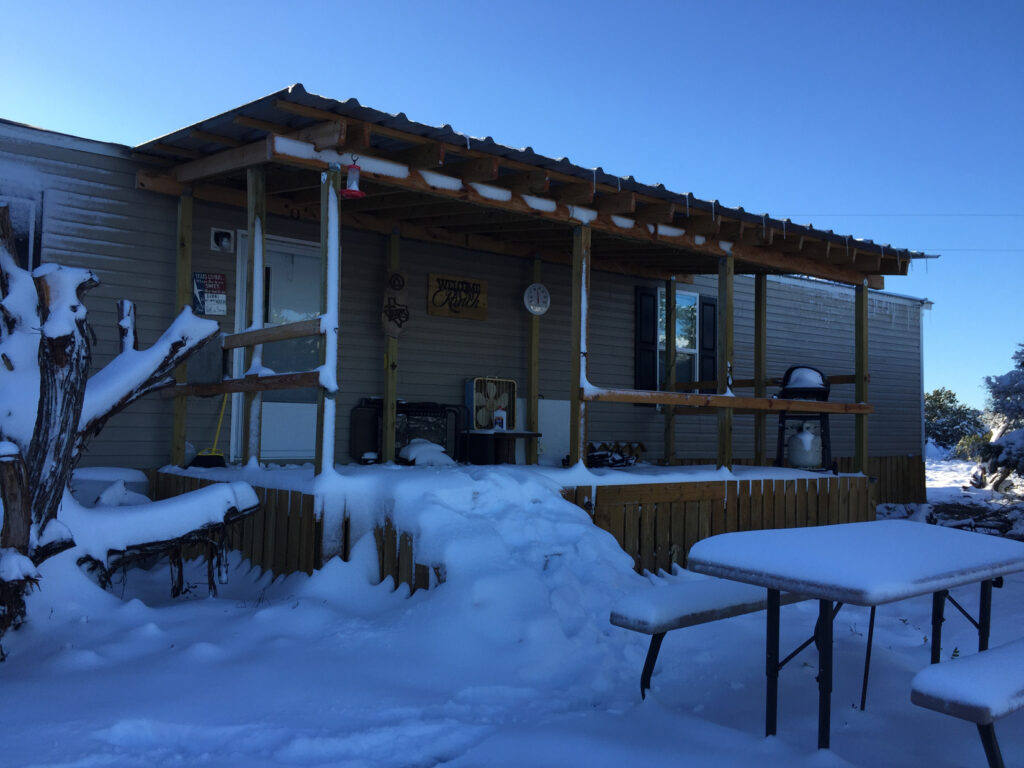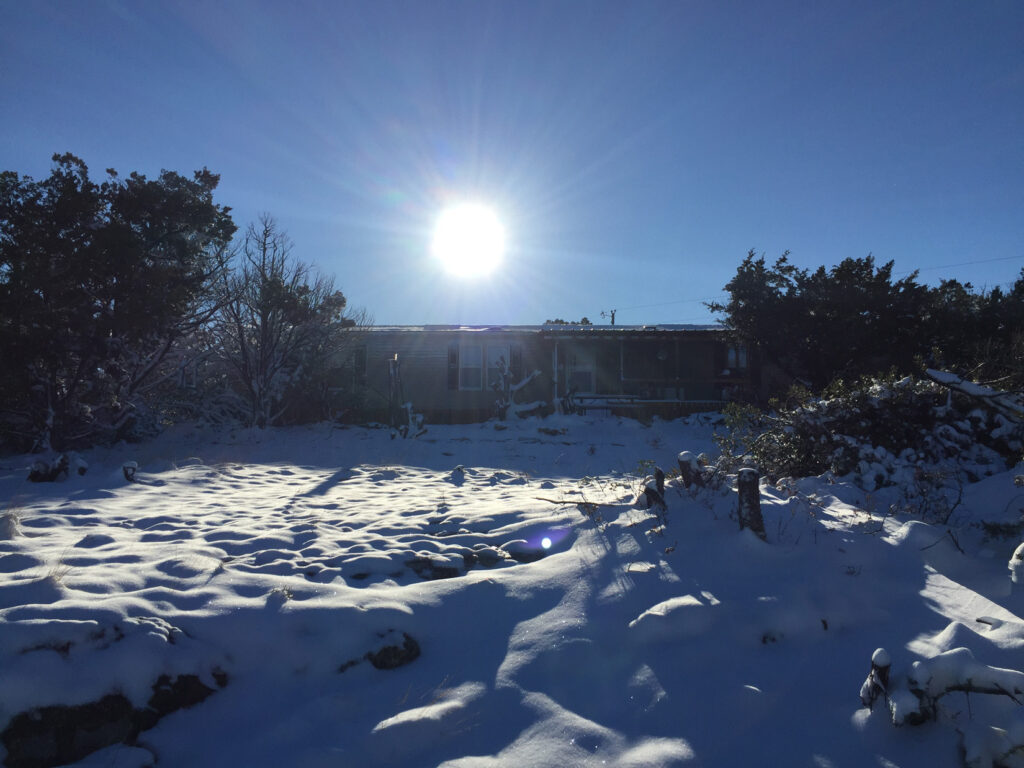






Many of us are interested in identifying all the plants and animals at Indian Creek, but up until now, it’s been quite an undertaking. You needed one identification guide for trees, one for grasses, two or three for birds, etc. etc., and then you had to wade through pages and pages to find the ones that could possibly be on the Edwards Plateau.
Well, now a lot of the information you need (and none of the extraneous stuff) is in one handy little book recently published by Texas A & M Press. A Naturalist’s Guide to the Texas Hill Country by Mark Gustafson has photos and information on everything from lichen to javelinas to cicadas.
The brief descriptions include things like range and helpful identification tips (Examples: a Texas persimmon’s leaves roll under; elbow bush gets its name from branches that come off at right angles), and are given in ordinary language. Need to know if that oak is a Lacey oak or a blackjack? Or if painted buntings are here in winter? You will find that info in this book.
Due to space constraints, not every possible species is shown. The emphasis in on species that are most likely to be encountered, whether they are common or unique. But still I found lots of species in this book I have not seen in any of my other field guides. And it is small enough to actually carry around outside with you while you are looking at the plants and animals.
Another nice feature is the last section of the book, which lists public places where Hill Country nature can be seen, places like Inks Lake and Kickapoo Cavern.
I did find one small mistake, where a Lesser Goldfinch is labeled as a House Finch, but the species description matched the photo, so I think most people could figure that one out.
I think it is an extremely useful book, and I look forward to using it to identify all those similar-looking shrubs and cacti we have!
Here are some pictures of the prescribed burn that Roger Lewellyn had at his place in February of 2016. He has created an informative 20-minute video about the planning and procedure. Even those who know something about prescribed burns can pick up a new fact or tip from the video.
You can click on the pictures to view a larger version.
(Indian Creek Ranch does not yet have a video team; 🙂 the video linked above is part of Roger’s YouTube series Indian Creek Bowhunting Journal.)
Recently three foundations petitioned the US Fish and Wildlife Service to remove the Golden-Cheeked Warbler from the Endangered Species list. Since Indian Creek is prime habitat for these birds, this could affect us, so here are some resources to help you learn about the issue.
Marshall Kuykendahl, who is for the de-listing, gave his opinion here in the Austin-American Statesman. Texas Wildlife Association also took takes this position, running an article by one of the petitioners, Robert Henneke, in their October 2015 magazine (although they have nothing about this issue on their website).
Those on the other side of the issue, in favor of keeping the warbler on the endangered list, also got a forum in the Austin-American Statesman. Their reasons were given by Joan Marshall, Executive Director of the Travis County Audubon Society.
This editorial from the Houston Chronicle and this one from the Austin-American Statesman both advocate keeping the warbler on the endangered list, at least for now. Both of these short editorials provide some background information.
For a look that goes beyond the simple “List it/De-list it” quandary, you might be interested in this article published by the Property and Environment Research Center. It is long, but it brings in many more facets of this issue. Author Richard Stroup argues that the Endangered Species Act has actually hurt targeted species, because many people have destroyed good habitat on their property, rather than face regulations. But rather than just assigning blame, it offers many solutions to the property rights/ regulation impasse:
A number of groups have been trying to come up with modifications of the Endangered Species Act that would provide incentives for landowner cooperation. One suggestion is to provide property tax credits for landowners who commit themselves to long-range habitat protection.(16) Another is to pay landowners “bounties” or “rewards” for endangered species found on their land.(17) Still another is to “rent” the land that is to be used for endangered species. – See more at: http://www.perc.org/articles/endangered-species-act-1#sthash.KGDaBmgP.dpuf
We are working on nature identification pages for the plants and animals at Indian Creek, but in the meantime, here are some great online resources to get you started.
The Department of Ecosystem Science and Management at Texas A & M University has a virtual herbarium. There you can browse all the plants from their books, Plants of Texas Rangelands, Toxic Plants of Texas, and Know Your Grasses. There is also a search page to help you identify plants — you click on your region, type of plant, or flower color, and then search further within those results by clicking on more characteristics. A list of possible plants comes up, and when you hover your cursor over the names, the plant’s picture comes up, so you can very quickly see if that is your plant or not.
Happy identifying!
Whitlow-grass is not a grass at all; it is a small plant with tiny white flowers, in the mustard family. And it is not named after some botanist who discovered it – it was thought to cure a whitlow, which is a word (that goes back to the 14th century!) for a deep inflammation on a finger or toe. As the plant only blooms from February to May, and its flowers are only a quarter inch across, you may have a hard time spotting it if you need it for it for its healing abilities, so I guess you should be extra careful with your fingers and toes during the rest of the year.
It is in the Draba genus which has many species in it. The USDA Plant Database shows about 130 species, but they only have pictures for about 33 of those! Based on my research, I believe the one we have is Draba cuneifolia. Another common name for it is wedgeleaf draba.
According to the Southwest Desert Flora website, it is common in Arizona, but in the East it is on several states’ lists of threatened or endangered plants.
Wildflower Center page for Draba cuneifolia. This picture was taken near Rockwall and looks just like the one we have growing on the ranch.
USDA page for Draba cuneifolia. You can see the characteristic hairs on the leaves if you click to enlarge the pictures.
Here are some samples from the Digital Herbarium, if you would like to compare one of your plants with a preserved specimen.
Latin names: Glandularia bipinnatifida
Verbena ambrosifolia
Spanish name (much prettier!): moradilla (little purple one)
Other common names: Dakota mock vervain
There is not a lot of information on the internet about this plant. No legends or associations with famous historical characters. But if you want more details, you can go to these websites:
Lady Bird Johnson page
Uvalde office of Texas AgriLife Extension page
This plant does not appear in Toxic Plants of Texas.
This plant grows in all ten vegetational areas of Texas!
The name comes from the way that its seedpods grow and curve.
Other common names are green-flowered milkweed, and spider antelope horns (in case one animal in the common name is not enough, I guess). If I got to name it, I would have called it Texas snowball.
Its Latin name is Asclepias asperula. It is listed in Toxic Plants of Texas, because it can be toxic to livestock. Fortunately, it tastes bad to them, and they will only eat it if they are penned up in an area with lots of milkweed and not much else.
While it may not be good for livestock or humans, being a milkweed, it is very important to monarch butterflies! It is also attractive to native bees, which, we are learning, are very important to the environment as a whole.
Here is its page at the Lady Bird Johnson Wildflower Center and here is its page at the Native Plant Society of Texas.
by Gwen Lanning
Managing for wildlife is a vast subject, and one that many of us are unfamiliar with when we first purchase our dream property. You look at your land and you don’t even know where to start — how can you tell if it is healthy? How can you identify areas that need help?
Here are two resources to help you evaluate habitat. The first one is a handout I picked up at a yearly wildlife management workshop in Houston. The author is Diana Foss, a TPWD biologist, and I am using it with her permission. She is headquartered at Sheldon Lake near Beaumont, so obviously some of these questions won’t apply to us in Edwards County (like most of the water questions), but still, I think this checklist can help remind you of important aspects of habitat management.
The next one is a blog post by a prairie restoration biologist in the Platte River area of Nebraska. Again, not all of his information will apply to us, but I think his criteria offer us good ideas.
One of our neighbors, Bob Pauken, has shared this information about building a water guzzler. Bob says that this design may not be easy to copy exactly, because he had access to some recycled materials, and some strong and skilled labor, but we think the information will be useful. If you do a similar project, please let us know!
And now, here is Bob’s description.
The idea for construction of a guzzler came from discussions with Randy Wood, someone else talking about his at the fall meeting, and seeing the one Gilbert Carmona built on his land. I wasn’t sure exactly how to go about the project so I was discussing the mechanics of it with a friend from Colorado, Rory Birdsey who is a ranch manager for Ernie Cockerl, owner of a ranch on the Taylor River there. One of the guests at the ranch last summer was Andrew Sansom, research professor at Texas State University and author of the book Water in Texas, an Introduction, from the Texas Natural History Guide series. He and Rory had in-length discussions about guzzlers. Rory then went to the internet and designed what he thought would be a working guzzler. He then set about collecting recyclable cabin metal roofing materials from around the ranch. One of his sons who works in the oil fields of western Colorado gained access to discarded drilling pipe. The materials were cut in Colorado to fit a 19ft. long and 16ft. wide structure to be hauled to Indian Creek ranch on a 16ft. trailer.